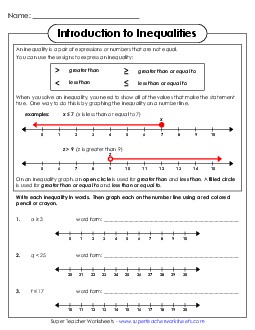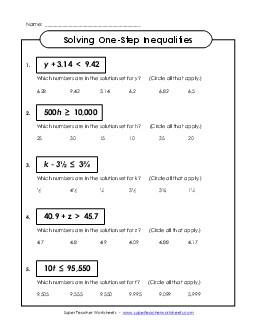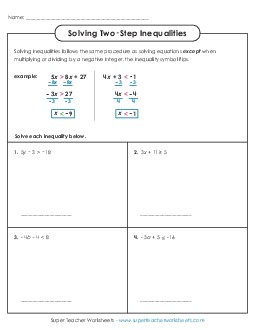Inequalities Worksheets

Introduction to inequalities. Solve and graph the inequalities with only one variable. Students graph the inequality.
They do not need to perform any steps to isolate the variable.
(example: a ≥ 7)
These inequality worksheets have one variable in each problem. Students need to isolate the variable using only one step.
(example: 12 - x ≤ 8)
Students will need to use more than one step to isolate the variable and solve the inequalities on these worksheets.
More Algebra WorksheetsThis page has very basic worksheets to help students identify dependent and independent variables, evaluate algebraic expressions and solve for variables in equations.



Inequalities are an important math topic introduced in upper elementary school and further explored in middle school, typically starting around fifth or sixth grade. Inequalities involve comparing two expressions to determine their relationship, using symbols such as greater than (>), less than (<), greater than or equal to (≥), and less than or equal to (≤). Learning about inequalities helps students develop a deeper understanding of how numbers and variables relate to one another, which is crucial for problem-solving in both math and real-life scenarios. As students advance, they move from simple numerical inequalities to more complex algebraic inequalities, where variables and equations come into play.
In the classroom, teachers use a variety of engaging methods to help students grasp the concept of inequalities. Early lessons often focus on using number lines to visually represent inequalities, which helps students see how numbers compare to each other. Classroom activities may include sorting cards with different inequality symbols and numbers, or solving real-world problems like comparing prices, distances, or weights using inequalities. As students move into middle school, they begin solving inequalities with variables, practicing how to isolate variables using addition, subtraction, multiplication, and division. Group activities, puzzles, and interactive math games can also make learning inequalities more engaging for students.
Understanding the core concepts of inequalities is essential for students because it lays the groundwork for algebra and more advanced math topics. Inequalities help students develop critical thinking and reasoning skills, as they must analyze and compare quantities and expressions. This knowledge is also highly applicable in everyday situations, from budgeting and comparing product prices to understanding statistical data. By mastering inequalities using the resources on Super Teacher Worksheets, students not only become more confident in their math abilities but also enhance their ability to solve real-world problems, making this topic a crucial stepping stone in their overall math education.






